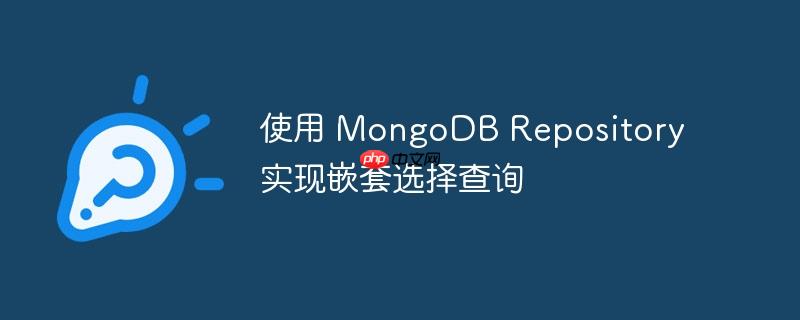
本文介绍了如何使用 Spring Data MongoDB Repository 和 MongoTemplate 在嵌套的文档结构中执行选择查询。通过示例代码展示了如何根据内嵌文档的字段值查找父文档,并提供了代码示例和使用注意事项,帮助开发者高效地实现复杂查询需求。
在使用 MongoDB 时,经常会遇到需要在嵌套的文档结构中进行查询的场景。例如,我们有一个包含数组字段的文档,数组中的每个元素又是一个包含多个字段的文档。我们需要根据数组中某个元素的字段值来查找包含该元素的父文档。Spring Data MongoDB 提供了强大的工具来应对这种情况,包括 MongoRepository 和 MongoTemplate。
假设我们有以下文档结构:
[{
"id": "classicId",
"name": "classicName",
"models": [
{
"id": "AnotherId",
"name": "AnotherSomeName"
},
{
"id": "RequiredId",
"name": "SomeName"
}
]
}]我们的目标是,给定 models 数组中某个元素的 id 值,例如 "AnotherId",找到包含该元素的整个文档。
以下是如何使用 MongoRepository 和 MongoTemplate 实现这个功能的步骤:
首先,我们需要定义一个与文档结构对应的实体类。
import org.springframework.data.annotation.Id;
import org.springframework.data.mongodb.core.mapping.Document;
import java.util.List;
@Document(collection = "your_collection_name") // Replace with your actual collection name
public class YourObject {
@Id
private String id;
private String name;
private List<Model> models;
// Getters and setters
public String getId() {
return id;
}
public void setId(String id) {
this.id = id;
}
public String getName() {
return name;
}
public void setName(String name) {
this.name = name;
}
public List<Model> getModels() {
return models;
}
public void setModels(List<Model> models) {
this.models = models;
}
public static class Model {
private String id;
private String name;
// Getters and setters
public String getId() {
return id;
}
public void setId(String id) {
this.id = id;
}
public String getName() {
return name;
}
public void setName(String name) {
this.name = name;
}
}
}创建一个继承自 MongoRepository 的接口,用于执行数据库操作。
import org.springframework.data.mongodb.repository.MongoRepository;
import org.springframework.stereotype.Repository;
import java.util.Optional;
@Repository
public interface YourObjectRepository extends MongoRepository<YourObject, String> {
// You can add custom query methods here if needed
}虽然可以在 Repository 接口中定义自定义查询,但对于这种嵌套查询,使用 MongoTemplate 通常更灵活。 创建一个方法,使用 MongoTemplate 构建查询条件,并执行查询。
import org.springframework.beans.factory.annotation.Autowired;
import org.springframework.data.mongodb.core.MongoTemplate;
import org.springframework.data.mongodb.core.query.Criteria;
import org.springframework.data.mongodb.core.query.Query;
import org.springframework.stereotype.Service;
import java.util.List;
import java.util.Optional;
@Service
public class YourObjectService {
@Autowired
private MongoTemplate mongoTemplate;
public Optional<YourObject> getByModelId(String theVariableWithTheValue) {
Query query = new Query().addCriteria(Criteria.where("models.id").is(theVariableWithTheValue));
List<YourObject> result = mongoTemplate.find(query, YourObject.class);
return result.isEmpty() ? Optional.empty() : Optional.of(result.get(0));
}
}代码解释:
使用示例:
@Autowired
private YourObjectService yourObjectService;
public void someMethod() {
String modelId = "AnotherId";
Optional<YourObject> yourObject = yourObjectService.getByModelId(modelId);
if (yourObject.isPresent()) {
System.out.println("Found object: " + yourObject.get().getName());
} else {
System.out.println("Object not found for model id: " + modelId);
}
}注意事项:
总结:
通过使用 MongoTemplate 和 Criteria,我们可以轻松地在 MongoDB 中执行复杂的嵌套查询。 本文提供的示例代码可以作为基础,根据实际需求进行修改和扩展。 掌握这些技巧可以帮助开发者更高效地使用 Spring Data MongoDB 操作 MongoDB 数据库。
以上就是使用 MongoDB Repository 实现嵌套选择查询的详细内容,更多请关注php中文网其它相关文章!

每个人都需要一台速度更快、更稳定的 PC。随着时间的推移,垃圾文件、旧注册表数据和不必要的后台进程会占用资源并降低性能。幸运的是,许多工具可以让 Windows 保持平稳运行。

Copyright 2014-2025 https://www.php.cn/ All Rights Reserved | php.cn | 湘ICP备2023035733号